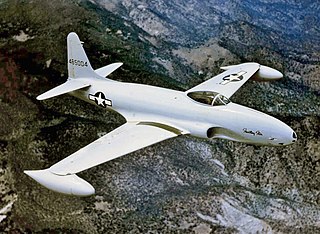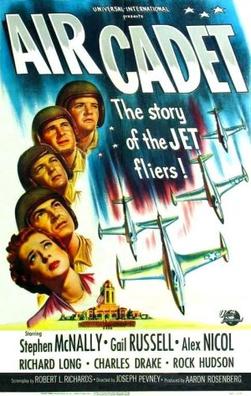
Brigadier General Charles Elwood Yeager was a United States Air Force officer, flying ace, and record-setting test pilot who in October 1947 became the first pilot in history confirmed to have exceeded the speed of sound in level flight.

The Lockheed F-117 Nighthawk is a retired American single-seat, subsonic twin-engine stealth attack aircraft developed by Lockheed's secretive Skunk Works division and operated by the United States Air Force (USAF). It was the first operational aircraft to be designed with stealth technology.

The Lockheed P-80 Shooting Star was the first jet fighter used operationally by the United States Army Air Forces (USAAF) during World War II. Designed and built by Lockheed in 1943 and delivered just 143 days from the start of design, production models were flying, and two pre-production models did see very limited service in Italy just before the end of World War II. Designed with straight wings, the type saw extensive combat in Korea with the United States Air Force (USAF) as the F-80.

The Right Stuff is a 1983 American epic historical drama film written and directed by Philip Kaufman and based on the 1979 book of the same name by Tom Wolfe. The film follows the Navy, Marine, and Air Force test pilots who were involved in aeronautical research at Edwards Air Force Base, California, as well as the Mercury Seven, the seven military pilots who were selected to be the astronauts for Project Mercury, the first human spaceflight by the United States. The film stars Sam Shepard, Ed Harris, Scott Glenn, Fred Ward, Dennis Quaid, and Barbara Hershey; Levon Helm narrates and plays Air Force test pilot Jack Ridley.

Richard "Dick" Ira Bong was a United States Army Air Forces major and Medal of Honor recipient in World War II. He was one of the most decorated American fighter pilots and the country's top flying ace in the war, credited with shooting down 40 Japanese aircraft, all with the Lockheed P-38 Lightning. He died in California while testing a Lockheed P-80 jet fighter shortly before the war ended. Bong was posthumously inducted into the National Aviation Hall of Fame in 1986 and has several commemorative monuments named in his honor around the world, including an airport, two bridges, a theater, a veterans historical center, a recreation area, a neighborhood terrace, and several avenues and streets, including the street leading to the National Museum of the United States Air Force in Dayton, Ohio.

The Mikoyan-Gurevich MiG-15 is a jet fighter aircraft developed by Mikoyan-Gurevich for the Soviet Union. The MiG-15 was one of the first successful jet fighters to incorporate swept wings to achieve high transonic speeds. In aerial combat during the Korean War, it outclassed straight-winged jet day fighters, which were largely relegated to ground-attack roles. In response to the MiG-15's appearance and in order to counter it, the United States Air Force rushed the North American F-86 Sabre to Korea.

The McDonnell XF-85 Goblin is an American prototype fighter aircraft conceived during World War II by McDonnell Aircraft. It was intended to deploy from the bomb bay of the Convair B-36 bomber as a parasite fighter. The XF-85's intended role was to defend bombers from hostile interceptor aircraft, a need demonstrated during World War II. McDonnell built two prototypes before the Air Force (USAF) terminated the program.

The Lockheed F-94 Starfire is a first-generation jet powered all-weather day/night interceptor aircraft designed and produced by Lockheed Corporation. It was the first operational United States Air Force (USAF) fighter equipped with an afterburner as well as being the first jet-powered all-weather fighter to enter combat during the Korean War.

Josef von Sternberg was an Austrian-born filmmaker whose career successfully spanned the transition from the silent to the sound era, during which he worked with most of the major Hollywood studios. He is best known for his film collaboration with actress Marlene Dietrich in the 1930s, including the highly regarded Paramount/UFA production The Blue Angel (1930).

The Convair XF-92 is an American, delta wing, first-generation jet prototype. Originally conceived as a point-defence interceptor, the design was later used purely for experimental purposes and only one was built. However, it led Convair to use the delta-wing on a number of designs, including the F-102 Delta Dagger, F-106 Delta Dart, B-58 Hustler, the US Navy's F2Y Sea Dart as well as the VTOL FY Pogo.

The Sound Barrier is a 1952 British aviation drama film directed by David Lean. It is a fictional story about attempts by aircraft designers and test pilots to break the sound barrier. It was David Lean's third and final film with his wife Ann Todd but it was his first for Alexander Korda's London Films, following the break-up of Cineguild. The Sound Barrier stars Ralph Richardson, Ann Todd, John Justin and Nigel Patrick. It was known in the United States as Breaking Through the Sound Barrier and Breaking the Sound Barrier.

Tonopah Test Range Airport, at the Tonopah Test Range is 27 NM southeast of Tonopah, Nevada, and 140 mi (230 km) northwest of Las Vegas, Nevada. It is a major airfield with a 12,000 ft × 150 ft runway, instrument approach facilities, and nighttime illumination. The facility has over fifty hangars and an extensive support infrastructure.

A fighter pilot or combat pilot is a military aviator trained to engage in air-to-air combat, air-to-ground combat and sometimes electronic warfare while in the cockpit of a fighter aircraft. Fighter pilots undergo specialized training in aerial warfare and dogfighting. A fighter pilot with at least five air-to-air kills becomes known as an ace.

The 357th Fighter Group was an air combat unit of the United States Army Air Forces during the Second World War. The 357th operated P-51 Mustang aircraft as part of the U.S. Eighth Air Force and its members were known unofficially as the Yoxford Boys after the village of Yoxford near their base in the UK. Its victory totals in air-to-air combat are the most of any P-51 group in the Eighth Air Force and third among all groups fighting in Europe.

The Lockheed NF-104A is an American mixed-power, high-performance, supersonic aerospace trainer that served as a low-cost astronaut training vehicle for the North American X-15 and projected Boeing X-20 Dyna-Soar programs.

The McConnell Story is a 1955 dramatization of the life and career of United States Air Force (USAF) pilot Joseph C. McConnell (1922–1954) directed by Gordon Douglas. McConnell served as a navigator in World War II before becoming the top American ace during the Korean War and was killed on August 25, 1954, while serving as a test pilot at Edwards Air Force Base in the Mojave Desert, California. The Warner Brothers production, filmed in CinemaScope and Warner Color, stars Alan Ladd as McConnell and June Allyson as his wife. Longtime Warners staff composer Max Steiner wrote the musical score for the film.

Kenneth Oscar Chilstrom was a United States Air Force officer, combat veteran, test pilot, and author. He was the first USAF pilot to fly the XP-86 Sabre, chief of fighter test at Wright Field, commandant of the U.S. Air Force Test Pilot School, and program manager for the XF-108 Rapier. Chilstrom was a pilot in the first jet air race and delivered the first air mail by jet. He flew over eighty combat missions in the Italian Campaign of World War II and tested over twenty foreign models of German and Japanese fighters and bombers to evaluate their strengths and weaknesses.

Air Cadet is a 1951 American drama war film directed by Joseph Pevney and starring Stephen McNally, Gail Russell, Alex Nicol and Richard Long. Air Cadet featured United States Air Force (USAF) pilots in training along with actors mixed into the training courses. The film had a small early role for 26-year-old Rock Hudson and a scene with future astronaut Gus Grissom.

Operation Moolah was a United States Air Force (USAF) effort during the Korean War to obtain through defection a fully capable Soviet MiG-15 jet fighter. Communist forces introduced the MiG-15 to Korea on November 1, 1950. USAF pilots reported that the performance of the MiG-15 was superior to all United Nations aircraft, including the USAF's newest plane, the F-86 Sabre. The operation focused on influencing Communist pilots to defect to South Korea with a MiG for a financial reward. The success of the operation is disputable since no Communist pilot defected before the armistice was signed on July 27, 1953. However, on September 21, 1953, North Korean pilot Lieutenant No Kum-Sok flew his MiG-15 to the Kimpo Air Base, South Korea, unaware of Operation Moolah.

Robert M. Bond was a lieutenant general in the United States Air Force (USAF). He saw combat in Korea and three tours in Vietnam, before becoming an instructor and then vice-commander of an organization which developed and evaluated weaponry for the USAF. He was decorated for his combat service and his peacetime role. He died in an accident in Nevada while flying a Soviet-built Mikoyan-Gurevich MiG-23 jet fighter-bomber.




















